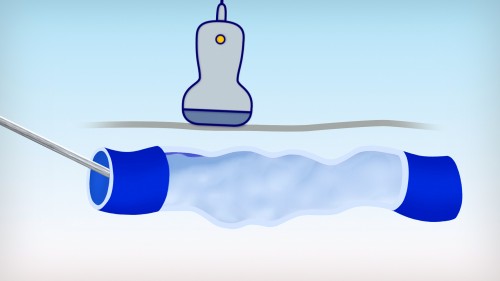Varicose veins should be treated early
Here you learn all about foam sclerotherapy

Sclerotherapy
Treatment of varicose veins with foam sclerotherapy
Sclerotherapy is a procedure for the treatment of varicose veins, in which the diseased vein is injected with a sclerosant to close it off and thus eliminate it.
Foam sclerotherapy involves injecting a special foam sclerosant into the varicose veins instead of the liquid sclerosant employed in conventional sclerotherapy. Modern foam sclerotherapy has revolutionised the treatment of varicose veins and is now used successfully on all types of varicose veins. It is even more effective than treatment with a liquid sclerosant and is therefore used for large varicose veins in particular. The recently issued National Institute for Health and Care Excellence (NICE) guideline recommends foam sclerotherapy as a good alternative and even in preference to surgical procedures for the treatment of trunk veins.
If varicose veins reappear after surgery (recurrence), these veins are particularly suitable for sclerotherapy.
As a minimally invasive procedure, foam sclerotherapy is painless and can therefore be carried out on an outpatient basis, without any anaesthesia or incisions. After treatment, you can resume your normal daily activities immediately and return to work without delay.
Advantages and disadvantages of foam sclerotherapy at a glance
Advantages of foam sclerotherapy
- Painless
- No general or local anaesthesia is required
- Can be carried out on an outpatient basis
- No incisions necessary, no resultant scars
- Numerous clinical studies are available
- Cost-effective; costs sometimes covered by statutory health insurance, otherwise you have to pay for treatment yourself (depending on the severity of the disease, treatment costs 100-250 EUR per session)
- The only method that can be used for all types of varicose veins
- A vein that has been treated can be treated again at any time; this is very difficult after surgery and not possible with thermal methods
- Easily combined with other methods – for instance, with procedures that are only suitable for trunk veins
- Normal daily activities can be resumed immediately and patients can return to work without delay
- Very suitable for the elderly or overweight patients
Disadvantages of foam sclerotherapy
- Several treatment sessions may be necessary to obliterate large varicose veins permanently
- It may take several weeks for the body to break down and resorb the varicose vein
- Allergies to the sclerosant and systemic reactions are possible, but only in rare cases
How foam sclerotherapy works
In sclerotherapy, the doctor injects a specially developed medicinal product, the sclerosant, into the varicose veins. Within the varicose vein, the sclerosant reacts with the vein wall. Natural processes in the body cause the vein walls to stick together and close off the vessel, so that blood can no longer pool in the vein. With time, the obliterated vein is converted into a strand of connective tissue, a process termed sclerosis. The body gradually breaks down the connective tissue strand and the vein disappears.
The functional results of sclerotherapy are thus equivalent to the surgical removal of a varicose vein.
Animation: Mode of action of foam sclerotherapy
The foam used in foam sclerotherapy basically acts in the same way as liquid sclerosant – but has an even more powerful effect, because the blood does not dilute and carry away foam as quickly as it does liquid sclerosant. This is particularly important in large varicose veins, as the foam can act longer on the vein walls making its effects more powerful.
Although foam sclerotherapy generally requires lower concentrations and smaller quantities of sclerosant, the goals of treatment are achieved more quickly in large varicose veins, i.e. the obliteration and elimination of the diseased veins.
Success rate of foam sclerotherapy
While sclerotherapy with liquid sclerosant is the treatment of choice for small varicose veins, foam is mainly used these days to treat varicose veins of the perforators, side branch veins, and trunk veins. Reliable evidence from a large number of studies has confirmed the efficacy of foam sclerotherapy and it is considered to be a good alternative to thermal and surgical procedures (German Society of Phlebology guidelines).
A recent analysis of all the studies found in the literature showed that the clinical results of thermal procedures, surgery, and foam sclerotherapy are all similar. All these methods of treatment are similarly effective and safe in treating large varicose veins.
The success rates depend on the precise technique, the concentration of the sclerosant used, the quantity of foam used, and on the diameter of the varicose veins. If the varicose vein has a very large diameter and treatment is stopped too soon, the adhesion reaction, in which the vein walls stick together, may not be sufficient to close the vein off permanently. In such cases, sclerotherapy can be repeated to optimise the treatment.
Sclerotherapy of large varicose veins usually requires more than one treatment session at the doctor.
Compression therapy optimises the results of sclerotherapy and should be used for some time after treatment.


